Louise Mott Miles
Home Economics
Many view home economics, or domestic science, as simply a plot to keep women in the kitchen. Historical sources show however that the field provided numerous opportunities for women. It secured a place in colleges and universities, and provided jobs after graduation in teaching, research, test kitchens, and extension services. Louise herself taught home economics to high school students for several decades after graduating from MTSTC.
Below are images related to home economics taught to and by many of the women in higher
education at the time.
Please note: Images may be subject to copyright restriction. Right assessment is the
responsibility of the researcher.
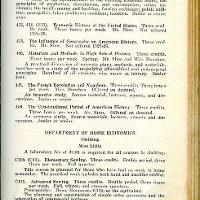 Home Economics course descriptions from the 1925–1926 Middle Tennessee State Teacher's
College Bulletin. This page shows sewing courses.
Home Economics course descriptions from the 1925–1926 Middle Tennessee State Teacher's
College Bulletin. This page shows sewing courses.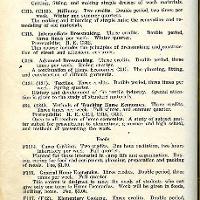 Home Economics course descriptions from the 1925–1926 MTSTC Bulletin. This page shows
courses in both sewing and cooking.
Home Economics course descriptions from the 1925–1926 MTSTC Bulletin. This page shows
courses in both sewing and cooking. Home Economics course descriptions from the 1925–1926 MTSTC Bulletin. This page show
courses offered in food, cooking, and household management.
Home Economics course descriptions from the 1925–1926 MTSTC Bulletin. This page show
courses offered in food, cooking, and household management.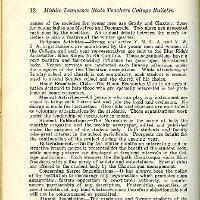 Description of the Home Economics Club, in the 1925–1926 MTSTC Bulletin.
Description of the Home Economics Club, in the 1925–1926 MTSTC Bulletin.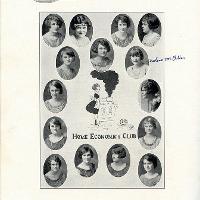 age from the 1924 Dryad showing the Tennessee College for Women Home Economics Club.
Louise Mott Miles is pictured in the second line from the top, furthest to the left.
age from the 1924 Dryad showing the Tennessee College for Women Home Economics Club.
Louise Mott Miles is pictured in the second line from the top, furthest to the left. Photograph of the Middle Tennessee Normal School home economics lab, taken from the
1916–1917 Bulletin.
Photograph of the Middle Tennessee Normal School home economics lab, taken from the
1916–1917 Bulletin.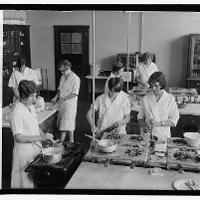 "Home Economics in College, 12/11/26", LOC LC-F8- 41346 [P&P].
"Home Economics in College, 12/11/26", LOC LC-F8- 41346 [P&P].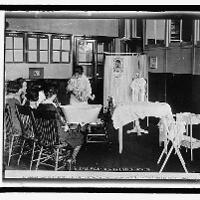 "Home economics in college, 12/11/26", LOC LC-F8- 41345 [P&P].
Besides the usual cooking and sewing, many colleges offered courses in child care,
allowing for a wider range of employment opportunities upon graduation.
"Home economics in college, 12/11/26", LOC LC-F8- 41345 [P&P].
Besides the usual cooking and sewing, many colleges offered courses in child care,
allowing for a wider range of employment opportunities upon graduation.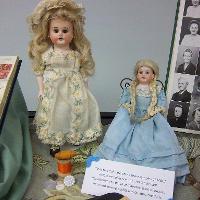 Two handmade dolls made by Louise Mott Miles. She enjoyed making them to showcase
her sewing skills, and was a member of the "Dixie Dollers," occasionally winning prizes
for her craft.
Two handmade dolls made by Louise Mott Miles. She enjoyed making them to showcase
her sewing skills, and was a member of the "Dixie Dollers," occasionally winning prizes
for her craft. Franke, Marie. Opportunities for Women in Domestic Science. Philadelphia: Association
of College Alumnae, 1916. From Cornell HEARTH http://hearth.library.cornell.edu/.
This book details employment opportunities available for women in the field of domestic
science, illustrating the empowering nature the field could have.
Franke, Marie. Opportunities for Women in Domestic Science. Philadelphia: Association
of College Alumnae, 1916. From Cornell HEARTH http://hearth.library.cornell.edu/.
This book details employment opportunities available for women in the field of domestic
science, illustrating the empowering nature the field could have. Louise Mott Miles was an example of the employment opportunities of domestic science.
This is her yearbook photo from the 1948 Central High School Megaphone, where she
taught math and home economics.
Louise Mott Miles was an example of the employment opportunities of domestic science.
This is her yearbook photo from the 1948 Central High School Megaphone, where she
taught math and home economics.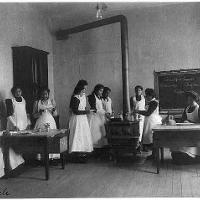 "Breakfast lesson in home economics class for women. Carlisle Indian School, Pa."
LOC LOT 12369 [item] [P&P].
"Breakfast lesson in home economics class for women. Carlisle Indian School, Pa."
LOC LOT 12369 [item] [P&P].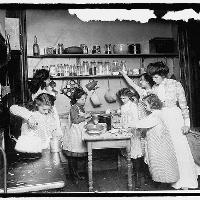 "Home economics in public schools, kitchen in housekeeping flat, New York" LOC LC-F81-
2037 [P&P].
Teaching was a common pursuit for home economics graduates.
"Home economics in public schools, kitchen in housekeeping flat, New York" LOC LC-F81-
2037 [P&P].
Teaching was a common pursuit for home economics graduates.  Human Ecology Historical Photographs, Cornell University Library, Collection 23-3-749,
Item PR-EM-15. Link below.
One employment option was the provision of extension services, from university or
government agencies, to community groups. Pictured is an extension hat-making course.
Human Ecology Historical Photographs, Cornell University Library, Collection 23-3-749,
Item PR-EM-15. Link below.
One employment option was the provision of extension services, from university or
government agencies, to community groups. Pictured is an extension hat-making course.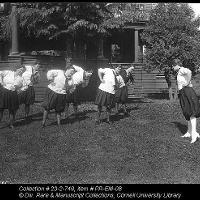 Human Ecology Historical Photographs, Cornell University Library, Collection 23-3-749,
Item PR-EM-08. Link below.
Pictured above is an extension course focusing on physical education.
Human Ecology Historical Photographs, Cornell University Library, Collection 23-3-749,
Item PR-EM-08. Link below.
Pictured above is an extension course focusing on physical education.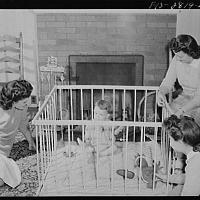 "Home economics students looking after the child that lives with them in one of the
home management houses at Iowa State College." LOC LC-USW3- 002819-D [P&P]
Experience working with young children could lead to future employment in childcare.
"Home economics students looking after the child that lives with them in one of the
home management houses at Iowa State College." LOC LC-USW3- 002819-D [P&P]
Experience working with young children could lead to future employment in childcare.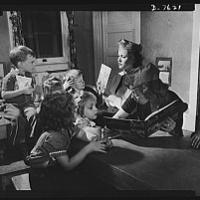 "To release housewives for war work, girls in high school Victory Corps throughout
America are helping to operate day nurseries." LOC LC-USE6- D-007621 [P&P]
During World War Two, home economists worked to benefit the country any way possible.
Here high school girls work in a nursery and receive home economics course credit.
"To release housewives for war work, girls in high school Victory Corps throughout
America are helping to operate day nurseries." LOC LC-USE6- D-007621 [P&P]
During World War Two, home economists worked to benefit the country any way possible.
Here high school girls work in a nursery and receive home economics course credit.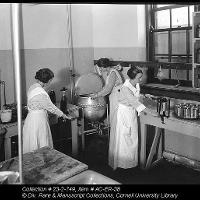 Human Ecology Historical Photographs, Cornell University Library, Collection 23-3-749,
Item AC-ER-38. Link below.
Home economics students demonstrated the use of canning as a means to conserve food
during World War One. Home economists found their work in high demand during wartime
as the nation worked to support the war effort.
Human Ecology Historical Photographs, Cornell University Library, Collection 23-3-749,
Item AC-ER-38. Link below.
Home economics students demonstrated the use of canning as a means to conserve food
during World War One. Home economists found their work in high demand during wartime
as the nation worked to support the war effort. Human Ecology Historical Photographs, Cornell University Library, Collection 23-3-749,
Item DD-C-09. Link below.
In this photograph, WWI servicemen are being fed by home economics students.
Human Ecology Historical Photographs, Cornell University Library, Collection 23-3-749,
Item DD-C-09. Link below.
In this photograph, WWI servicemen are being fed by home economics students.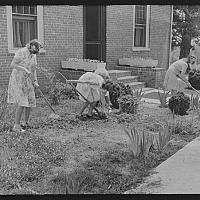 "Keysville, Virginia. Working in garden of home economics cottage of Randolph Henry
High School." LOC LC-USW3- 033382-E [P&P] LOT 968.
This photograph depicts WW2 era home economics students a garden. Food preservation
and conservation became extremely important during wartime.
"Keysville, Virginia. Working in garden of home economics cottage of Randolph Henry
High School." LOC LC-USW3- 033382-E [P&P] LOT 968.
This photograph depicts WW2 era home economics students a garden. Food preservation
and conservation became extremely important during wartime.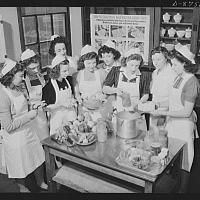 "Preparation for point rationing. A home economics class of the McKinley High School,
Washington, D.C., gets a practical lesson in home canning of fruits and vegetables,
looking toward supplementing the limited allowance of canned foods." LOC LC-USE6-
D-008751 [P&P]
Foods grown in a home garden could supplement limited family rations. Home canning
could preserve these foods throughout the year, so the skills women learned in home
economics courses prepared them for life during wartime.
"Preparation for point rationing. A home economics class of the McKinley High School,
Washington, D.C., gets a practical lesson in home canning of fruits and vegetables,
looking toward supplementing the limited allowance of canned foods." LOC LC-USE6-
D-008751 [P&P]
Foods grown in a home garden could supplement limited family rations. Home canning
could preserve these foods throughout the year, so the skills women learned in home
economics courses prepared them for life during wartime.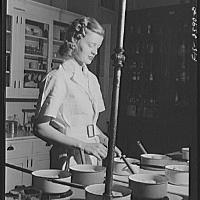 "Helen L. Hanson, research assistant, working on problems connected with frozen foods.
In the Home Economics Department at Iowa State College." LOC LC-USW3- 002590-D [P&P]
Women trained in home economics could also pursue careers in food research and product
development. In this image, a researcher studies how to overcome problems caused when
freezing food.
"Helen L. Hanson, research assistant, working on problems connected with frozen foods.
In the Home Economics Department at Iowa State College." LOC LC-USW3- 002590-D [P&P]
Women trained in home economics could also pursue careers in food research and product
development. In this image, a researcher studies how to overcome problems caused when
freezing food.
Pages in this exhibit
Albert Gore Research Center
P. O. Box 193, 1301 E. Main St.
Middle Tennessee State University
Murfreesboro, Tennessee 37132
Main: 615-898-2632
University Archives: 615-898-5202
Director: 615-898-2633
Location
Todd Hall Suite 128
Hours
Monday - Friday
9:00AM - 4:00PM
Or by appointment
Summer Hours
Monday - Thursday
9:00AM - 4:00PM
Friday
Closed



